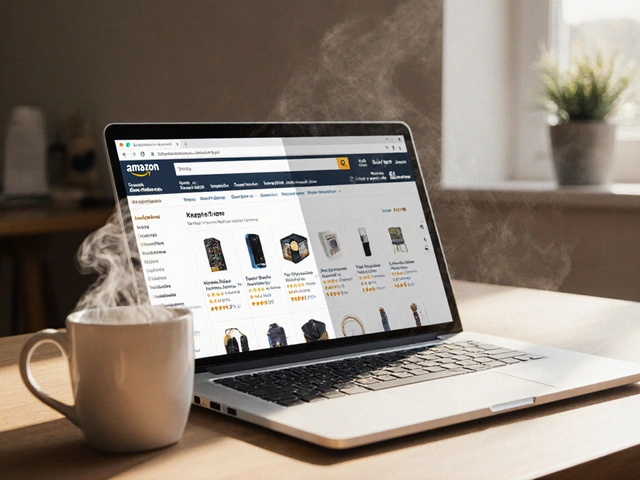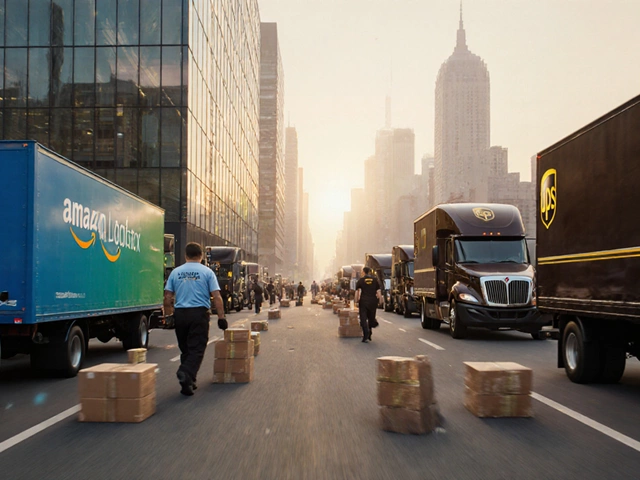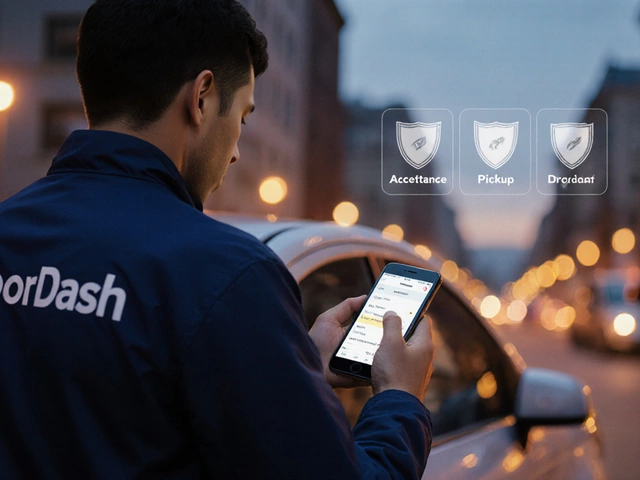Sticker shock is real when talking about logistics software. You’ll see prices all over the map, and it’s easy to lose track of what you’re actually paying for. A small business shipping a few packages a day will need something very different—and much cheaper—than a giant warehouse with trucks going out every hour.
The truth is, there's no one-size-fits-all price. You could be looking at $40 a month for basic cloud tracking or shelling out $100,000+ for an in-depth, fully customized system built just for you. But those numbers only tell part of the story. The real sticker price isn’t just about the basic subscription. There are setup fees, training, updates, and sometimes charges for adding new users or features you thought were included.
If you’re tired of hidden costs and confusing pricing tiers, you’re in the right place. Let’s break down the real costs behind logistics software so you can spot red flags and spend wisely.
- The Range: Typical Costs Explained
- What Impacts the Price
- Hidden and Extra Fees to Expect
- Tips to Get the Best Deal
The Range: Typical Costs Explained
If you’ve ever shopped for logistics software, you know prices are all over the place. That’s because what you pay pretty much depends on your business needs, the features you want, and whether you’re aiming for cloud-based or self-hosted software.
On the low end, small businesses might use entry-level tools that cost around $40 to $100 per month per user. These usually cover order tracking, basic inventory management, and some reporting. You can sign up fast, and there’s often a free trial. If you outgrow that level, some mid-range solutions fall between $200 and $600 a month, or sometimes charge $1,000 to $10,000 a year. These services bring extras like route optimization, integrations with shipping carriers, real-time tracking, and API access, which matter as your operation gets more complex.
On the high end, custom-built enterprise-level tools are a whole different beast. Companies can easily spend $50,000 to $250,000—or even more—on that type of system. There’s usually a big upfront fee for setup, custom tailoring, and integration, plus yearly licensing that can hit six figures. These advanced platforms are what Amazon, FedEx, and huge 3PLs rely on to keep thousands of shipments moving every hour.
You’ll also find pay-as-you-go options out there, which charge based on how many shipments you process or the number of users logged in. If your business is seasonal, this could keep costs down during your slow months.
Bottom line: there’s no secret “average” price for logistics software. Think about what you really need now, and how you’ll grow so you can avoid overpaying for bells and whistles you’ll never use. And remember to look beyond monthly costs—the real number adds up with extras like onboarding, data migration, and ongoing support.
- Entry-level: $40-$100/month/user
- Mid-level: $200-$600/month, or $1,000-$10,000/year
- Enterprise/custom: $50,000-$250,000+ (upfront and yearly fees)
- Pay-as-you-go: based on shipments or active users
Whatever route you take, make sure you’re getting solid logistics software cost transparency right up front. Surprises are only fun when they don’t show up on your invoice.
What Impacts the Price
Wondering why one company's logistics software is $50 a month while another is charging thousands? It's not just random. Several things have a big say in what you’ll pay, and it pays to know these upfront.
Here’s what really makes up the cost:
- Features and Functionality: Basic tracking and route planning cost way less than advanced stuff like real-time fleet management or AI-driven forecasting. The more bells and whistles, the higher the price tag.
- User Count: A tool for one dispatcher is cheaper than a setup for a team of fifty. Most companies charge per user, or they might have user-pack tiers (like up to 10 users, up to 50, and so on).
- Deployment Type: Cloud-based (SaaS) software typically charges monthly or yearly. On-premise (where you install it on your own servers) usually means a big upfront payment, and sometimes extra for updates.
- Customization: Off-the-shelf systems are cheaper. The second you want to tweak things—like special dashboards, workflow changes, or integrations—the price climbs.
- Integration Needs: Connecting with your other software (like ERP or inventory systems) could add both time and money, especially if it requires custom builds or support.
- Support and Service: Basic tech support might be included, but if you want 24/7 help, dedicated support staff, or in-person training, expect to pay more.
To give a better picture, here’s a quick comparison of estimated annual costs based on different business needs, according to a 2024 industry survey:
| Business Type | Features | Deployment | Average Annual Cost (USD) |
|---|---|---|---|
| Small retailer | Basic order tracking | Cloud | $600 - $2,500 |
| Mid-size carrier | Fleet & routing | Cloud/Hybrid | $8,000 - $35,000 |
| Large 3PL | End-to-end logistics, integrations | On-premise/Custom | $50,000 - $250,000+ |
The logistics software cost goes up fast depending on your business and tech choices. Always line up what you really need before getting dazzled by features—or by rock-bottom starter prices that leave out must-haves.

Hidden and Extra Fees to Expect
Logistics software isn’t always as straightforward as it looks on the pricing page. There are plenty of extra costs that sneak up, especially if you’re trying to get everything set up fast or need a lot of people using the software. Skip reading the fine print, and you could get hit with some surprise invoices.
Here are a few extra fees you’ll probably see at some point:
- Onboarding and setup — Many platforms charge a one-time fee for getting your system up and running. This often ranges from $500 to $5,000, depending on how much data they’re importing, how custom you want things, and if you need system integrations.
- Training — Don’t expect free education. For in-person or extensive remote training, companies may charge per session or per user. This adds up, especially for large teams or complicated software.
- Integrations — Want to connect your new logistics software with accounting, CRM, or warehouse tools? Expect higher charges, especially for custom integrations. Sometimes, the fee is per integration.
- Support — Basic email support is usually included, but live phone help, priority service, or a dedicated account manager? That often costs extra, with premium support plans running anywhere from $50 to $500 a month.
- Adding Users — You may get priced by user or by user “tier.” Bringing on a new dispatcher or driver can add to your monthly bill.
- Feature Add-ons — What’s included in the basic plan is usually pretty barebones. Alerts, in-depth reporting, mobile access, API usage, or advanced analytics can trigger more fees.
- Upgrades and Customization — Need your own workflows or custom dashboards? Custom programming is almost always extra and can be pricey.
- Data Storage — If you’re tracking years’ worth of shipping or inventory data, watch for storage limits and extra charges for “overages.”
Here’s a quick table showing some real-world examples of typical extra fees you could run into when paying for logistics software:
| Fee Type | Typical Cost Range | When It Pops Up |
|---|---|---|
| Setup/Onboarding | $500 – $5,000 (one-time) | At sign-up, initial implementation |
| Custom Integrations | $1,000 – $10,000 (one-time) | Connecting software to other apps |
| Extra Users | $10 – $100 per user/month | Scaling team, adding drivers |
| Premium Support | $50 – $500/month | Priority or live support |
| Data Overages | $10 – $200/month | Exceeding data storage limits |
| Advanced Features | $20 – $200/month per module | API, analytics, reporting modules |
The most overlooked part? Some companies even charge a fee if you want to get all your data back when you leave, called a “data export fee.” That’s why comparing true logistics software cost means more than just glancing at the subscription price each month.
If you’re serious about budgeting, always ask for a complete breakdown of all possible fees in writing before you start any contract. Trust me—it’ll save you cash, time, and headaches down the road.
Tips to Get the Best Deal
Getting the best price on logistics software cost isn’t about just going with the cheapest system you can find. There’s more to the game than sticker price. What really matters is making sure you’re paying for what you need, not what you’ll never use—or worse, paying extra for stuff you thought was included.
Don’t rush negotiations. Take your time comparing offers. Cloud-based logistics tools usually start as low as $50 a month per user, but enterprise solutions can get into the five-figure range per year. That’s a wide spread, and software vendors expect you to bargain. In 2023, Capterra surveyed over 1,000 software buyers and found that 67% got a lower price just by asking.
- Be upfront about your budget: Let vendors know what you can pay. They may shave off setup fees or toss in features for free.
- Request all fees in writing: Setup, support, API access, updates—all of it. Never sign before you see the full cost.
- Test-drive first: Most top logistics products let you try before you buy. Always use a free trial—get your real team to test, not just the IT guy.
- Don’t overbuy: Fancy dashboards look cool, but if all you need is reliable shipment tracking and order processing, skip the bells and whistles. Ask for stripped-down pricing.
- Ask about user limits: Some solutions charge you for every single user, while others stick to a flat fee. Do the math and pick the structure that saves you most as you grow.
Here’s a snapshot of what different business sizes typically spend on logistics software:
| Business Size | Typical Monthly Cost | Typical Setup Fee |
|---|---|---|
| Small (under 10 users) | $50 - $250 | $0 - $1,000 |
| Medium (10-50 users) | $250 - $1,200 | $500 - $5,000 |
| Large (50+ users) | $1,200 - $7,000 | $3,000 - $25,000 |
One solid strategy is to get references from customers just like you. If a competing business saved thousands with another provider, you want to know. And don’t forget the hidden upgrades—ask what features are coming in the next year and whether you'll get them without extra cost.
“Never assume the first price is the final price. There’s always room to negotiate with logistics software, especially if you’re buying for multiple users or planning to grow.” – Paul Robertson, freight tech consultant at FleetOps
The bottom line? Do your homework, push for transparency, and never settle for a one-size-fits-nobody type of deal.





